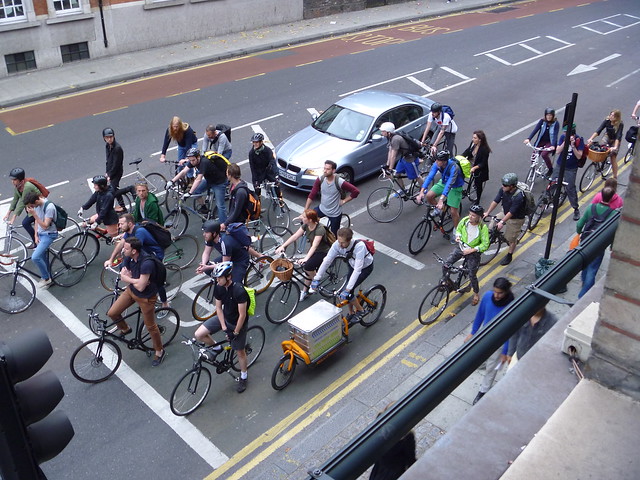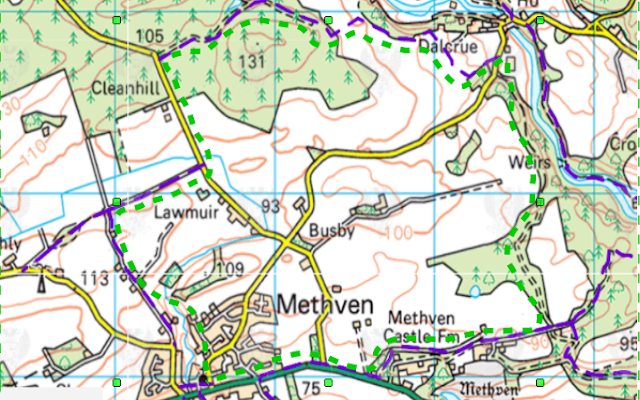This is the second part of a story that started
here.
On the way past Methven Castle farm, going east, I hadn't seen a soul. Max was off the lead. If we approach farmyards with buildings on both sides, he is usually leashed because of chickens, dogs, people, machinery. More often than not he refuses to advance, apparently through fear of livestock & I have to carry him - a large, hairy, invariably muddy bundle. Despite being a rescue dog, over the last year he has developed better recall than I have seen in some farm dogs. He was near me as we approached the farm, the place seemed deserted.
On the return, approaching the same farm from the opposite direction, three or four dogs under no sort of control shot out from a field on the right, crossed the track at speed and disappeared into the farmyard. They were followed by a woman who glanced in my direction and shouted at me to put my dog on a lead. Max was standing on the path just ahead of me, ears pricked, staring at where the dogs had disappeared. He returned when called and I did put him on the lead in case he decided to exercise his good judgement on bad characters and start barking at her aggressively. With hindsight it would have been unlikely given the number of dogs and his fear of farmyards. Most people in my experience, unfortunately do as ordered by controlling types whether the martinet is right or wrong. Controlling types are inevitably wrong yet, doubly misdirected, are convinced by their rightness. Most people I have met say they obey the many signs that abound, put up as a deterrent, unaware they are deterrents and illegal.
But on reflection, why should this woman, a stranger to me, issue orders to people? Why should she demand my dog already under control be leashed, particularly when several of her own were neither leashed nor controlled. The track is a well-used core path. The farm buildings are to one side of it. What jurisdiction do the people here have to issue orders to others quietly going about their business? A minority of dogs may chase sheep, but then a minority of people steal, fight and cheat. Do we, without knowing anything about them, order everyone about just because we expect them to behave that way, because we don't trust them? Not normally, but in the country, some landowners do, despite having no right to do so.
A few steps ahead an older man in country clothes had just pulled up in a large black vehicle. He said to me, certainly not in apology, "There's sheep in that field and the next one". Why say so? My dog was already leashed. I began to wonder if they were bullies.
If we have to go through a field of sheep, Max, a fearful soul through and through, tugs at the lead desperate to get away from them. I looked at where the man was pointing. There were indeed sheep, - two fields and two fences distant. If you zoom in you'll see them.
The second lot of sheep he'd meant were a good quarter of a mile away, down by the road, behind substantial fencing. If some landowners had it their way, dogs would never be off the lead in the country. Other people's dogs that is.
But I simply asked if he knew who the woodland mentioned in the last post belonged to. Quite civilly, he gave me the name of the man and the farm which he said was on the Crieff Rd. I thanked him." You're welcome," he said in a tone of continued civility. I went on my way.
He got into his vehicle and drove probably less than a hundred yards towards the sheep he'd just indicated.
I thought perhaps he was going to feed them. But he got out again and hailed a tall man with a ginger beard and a boy coming up the path, next to the field. I'd met them earlier coming the other way earlier. We'd said hello.
The vehicle track on the left and what looks like a path on the right.
In a dramatic change of tone the country man said, "What are you doing on that path?" Earlier, I had noticed a sign on the main track near where I am standing saying "Please stay on the path", which I thought potentially confusing, not to mention probably illegal.
There is also a sign just up from the actual path by the field (not the track on the left) saying Private House. I had thought the latter was quite sensibly informative rather than e.g. Keep Out.
The tall man looked at his phone and replied, with heavy sarcasm, "Oh, I'm so sorry".
Country Man: "This is a private drive to a private house. How did you get on to it anyway?"
The tall man muttered: "Walked up, walked back."
I wished he was a bit more forthright but then he hadn't seen, as I had, that there seemed to be a pattern of harassment.
I said to the country man: "It's not obvious that path is a private drive. It looks like path."
Country Man: "It is private and there's a sign at the bottom there."
"Did you see any sign?" I asked tall man.
He shrugged and said: "He can say what he likes, he doesn't own Scotland."
The country man, possibly feeling more challenged than he had expected then said, rather lamely: "It's not my drive. It belongs to the man at the bottom." But the tall man had moved on in apparent disgust.
I was tempted to say "Don't you have enough problems of your own?" but what was the point? Perhaps what I might have asked was: "How many people have you harassed on this track, today?" More usefully, in the future I might ask: "What exactly is it that upsets you so much about people using this track?" They must have a reason.
The country man got back in his car and drove the hundred yards back again to the farm.
I heard later that the landowner here is trying to get this core path closed. I don't know if there are any grounds on which he can do this. So far he has been unsuccessful.





























